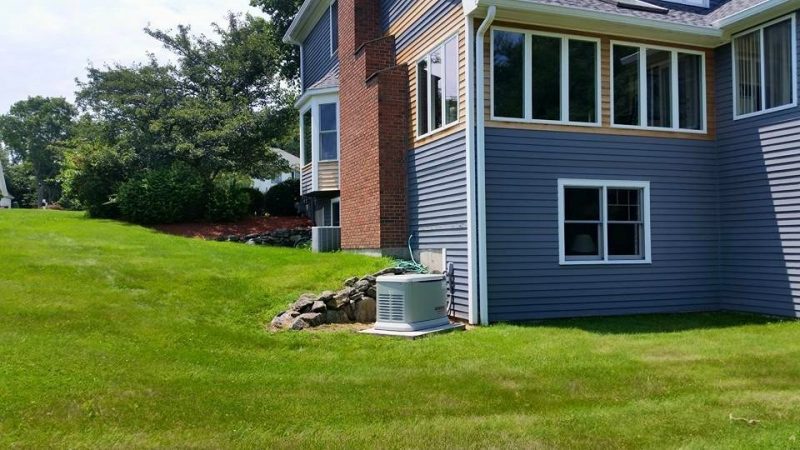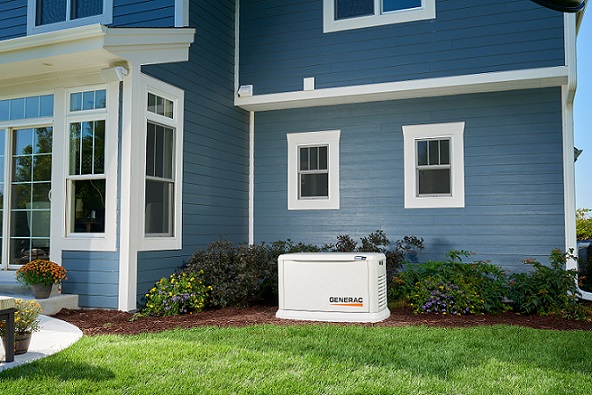Electric generators help to prevent the problems with electricity; they can be installed permanently or they can be used in case of emergencies.

The right place to install a generator
The generator is installed inside or outside your home and it depends on the circumstances around.
If the generator is not appropriate for the street, it can be installed in a basement, garage, or other utility room.
With this type of installation, it is necessary to obey the number of safety measurements.
⦁ Think of the sound insulation of the room or garage
⦁ Organize ventilation on an ongoing basis
⦁ Make sure that the room is dry
⦁ Provide for fire prevention measures
There are many spots to place a generator; when you decide to place it outdoor, make sure to fit it with the mechanism case to protect the engine and internal components.
That is how you can prevent them from the rain, dirt, and direct sunlight.
This case also helps to suppress the noise when the generator is running.
In order to get greater protection, the whole unit should be placed under a canopy.
It is recommended to leave a free space of at least one meter around and two meters above the installation near the generator.
To minimize the vibrations in both situations, it is suggested to place the generator on a flat surface (at least 15 to 20 cm thick concrete is preferred).
Sometimes it is not possible during outdoor installation because of uneven ground or sand.
In this situation, two wooden beams are positioned under it.
Starting the generator
The generator is conveyed unfilled, so after unpacking and visual examination, you have to install the battery and fill the generator with fuel and oil.
For a gasoline generator with a manual start, it is recommended that you pull the starter handle sharply.
It is easier to install the device: you just have to press the on button on the board.
After starting and before shutting down the generator, run the engine for 2 to 4 minutes at the slightest load.
During operation, the load should be 25 and 75 percent. In this sort of operating fashion, the generator will last longer.
In the attached manual for the generator, the manufacturer demonstrates the qualities of the lubricants.
It is worth sticking to these suggestions; these will help you to avoid breakdown and premature failure of the generator.
How to serve correctly?
The generator will last long and effectively if properly maintained. Before each start, a visual examination and checking of fuel and oil levels must be carried out.
To check the oil level, you need to place the generator on a flat surface, loosen the oil dipstick and wipe it with a dry clean piece of cloth.
Pour oil into the engine crankcase through the oil filler neck and tighten the dipstick.
After that, unscrew the dipstick again and check the level: the oil trail should be no lower than the low mark and no higher than the high mark.
If there is not enough oil, it should be poured through the filler into the crankcase.
Service function must be conducted according to the schedule specified in the installation manual.
For example, for professional diesel generators, the service frequency is 250 hours or six months of working.
Additionally to the external examination and checking the fuel, oil, and coolant level, we advise you to check the condition of the battery, changing the oil filter.
It is good if you replace the fuel filter every 500 hours. Shut down the engine before the replacement of fuel, lubricants, or performing maintenance.
If you are using a generator as a backup source and operating it continuously, it must not be idle, otherwise, its resource will be reduced.
How to store the generator correctly?
If you are using the generator rarely, it should be properly protected. It will help you to prevent the negative effects of prolonged downtime.
The engine should be cleaned from the outside; drain fuel and oil and replace it with preservatives.
If it is not possible to use preservative parallels, you can fill in with usual fuel and oil, but after the storage period has expired, drain and replace the fuel and oil filters.
With the purpose of preserving the equipment, it is crucial to hold a specific climate in the room where it is stored.
There should be humidity no more than 90%; you can even use heaters in the cold session.
The generator should not be entirely discharged, therefore the battery must be fully loaded every three months.
Also Read: Off-Grid Living on 225 Square Feet Tiny House
Details with noise
This is one of the factors that we cannot neglect when we talk about installing an electric generator, particularly if it is huge and you are not able to move it as many times as you would with a laptop.
If you have the guidance of an architect or engineer, you can add some supplies to cut off the noise produced by these devices.
Another possibility is to buy an apparatus that is soundproof, a quality that is valued because it lowers the inconvenience that these devices can cause to the people around them.
And if you are going to install the electric generator in closed workspaces, keep in mind that it must obey the standards established by the laws of that city or country.
Watch the ventilation
When an electric generator gets underway, it releases gases that can cause issues due to poisoning or unhealthy circumstances.
But it is not only the gases, it also generates heat that can create risky situations or permanently impact the endurance of your apparatus.
Therefore, it is desirable to install the generator in locations where there are abundant air currents to remove any trouble with fuel fumes or heat from the engine.
The right thing is that you verify all the possible locations to install your new electric generator and make the finest decision in this regard, always thinking about your ease and comfort.
Where to connect the generators?
There are two types of electric generators that you can install to provide electricity in your home.
⦁ Fixed
⦁ Portable
Each one has a different way of connection and it all depends on its features.
⦁ Portable generators

This type of generator is not intended to supply electricity for a long time of hours, but it will provide you the facility of energy for an average of 12 to 20 hours.
It is connected to your board through a manual transfer switch.
We recommend you not to consult the Internet, but contact a specialist to make sure you find the legal connections which you can make since they are not all accessible in all regions.
Furthermore, install a receptacle where you want to position this electric generator so that it will later allow you a connection with a male socket anywhere you need to have it.
Above all, before positioning your generator, keep in mind to place it in a ventilated place and where people do not pass often.
⦁ Fixed Generator

This type of generators requires a different connection; as their name suggests they are fixed, which means that their stay in the place where they are going to be positioned is long, and should supply the energy for a long time.
To initiate its connection, we must detach the electrical panel from the main outlet to be able to handle it without any trouble.
It then makes the direct relations to the board, through a current transfer to measure whether or not the outlet is producing the electricity it should.
Using a screwdriver with an insulating rubber, remove the screws necessary for connecting the apparatus.
At the end, when all the cables are in place, you can reconnect the power, and check if the electric generator is working properly or not.
Safety measures for installing electric generators

| ⦁ Keep the cables out of reach in order to avoid the risk of falls, particularly in locations with poor lighting or places where they can go unnoticed; that is how you will avoid accidents. |
| ⦁ Utilize the movable electric generator on a solid, strong surface without roughness, thus avoiding the risk of tipping over. |
| ⦁ Clear and clean the surface on which you are going to handle the movable electric generator, remove water, dirt, flammable materials, or spilled fuel. |
| ⦁ Make sure your hands are not wet when operating the unit. |
| ⦁ It is recommended not to put heavy objects on the generator; if necessary place some protection between this object and device. |
| ⦁ It is suggested not to manage the electric generator indoors, in an unventilated or closed space, including garages, between plants, sheds, or similar regions. |
| ⦁ Install the generator almost 23 feet from windows, doors, and vents to stop carbon monoxide from entering your home. |
| ⦁ Install a carbon monoxide detector alarm nearby and make sure you have an extra battery in your home. |
| ⦁ Make sure the generator is properly grounded. |
| ⦁ Keep in mind that an electric generator is a temporary source of power and will never be a final solution. |
| ⦁ Shut down or unplug all other electrical appliances in your home before operating the electric generator. |
| ⦁ Once the generator is functioning properly, the electrical appliances should be turned on one by one. |
| ⦁ Use only high-quality and certified cord extensions particularly designed for outdoor use and heavy-duty. |
| ⦁ Check these extensions for cuts regularly. |
| ⦁ It is recommended not to overload the electric generator or generator set. |
| ⦁ Never connect your generator directly to home wiring without first installing a transfer switch. |
When installing generators indoor, you must have the following components:
⦁ Ventilation system for the flow of cold air from the street to cool the generator
⦁ Ventilation system for the outlet of hot air from the radiator of the diesel generator set
⦁ Exhaust gas discharged arrangement to the street
⦁ A special industrial fan
When installing generators outdoor, you must consider the following components:
⦁ Protection from the external environment with soundproof and weather-resistant casing
⦁ Generator site
⦁ Heating procedure in the cold season
Generator benefits
An electrical generator can be used to produce electricity from non-electrical forms of energy, such as mechanical energy. This appliance is very handy today, and most importantly, it is mobile.
Generators are utilized today in almost every construction site, enterprise some even install it in their apartment and home.
Large companies, completely dependent on electricity, also install several extra production generators, since a minute absence of electricity can create a huge loss in business.
Each kind of generator has its own advantages and disadvantages, so, when selecting a generator, it is essential to focus on the circumstances in which it will be installed and used.
According to the information mentioned on Generator Sage, If a generator is required for rare use, then a gasoline generator is suitable, since it is inexpensive.
If electricity needs to be produced continuously, then it is better to pick diesel generators that are ready to assist for years as the main source of electricity.
Last words
Picking a generator relies on the minimum requirements of your location.
For small sites, a portable one is best to install, however, if you are supplying large buildings with high usage of electricity, such as hospitals, laboratories, schools, or museums, look for an industrial one.
You must also take into account the electrical voltage and power according to your electrical equipment or the most approachable type of fuel in your region.
It makes sense to purchase a dual-fuel electric generator that can be switched to the gas mode when the house is attached to the main gas pipeline.
However, the purchase of gas cylinders, the trouble of refueling them, and the growing gas price cancel the advantages of such an installation.
We tried our best to explain the stable electricity supply for your home.
We hope this guide will be beneficial for you when you are about to buy and install an electric or gasoline generator in your home.